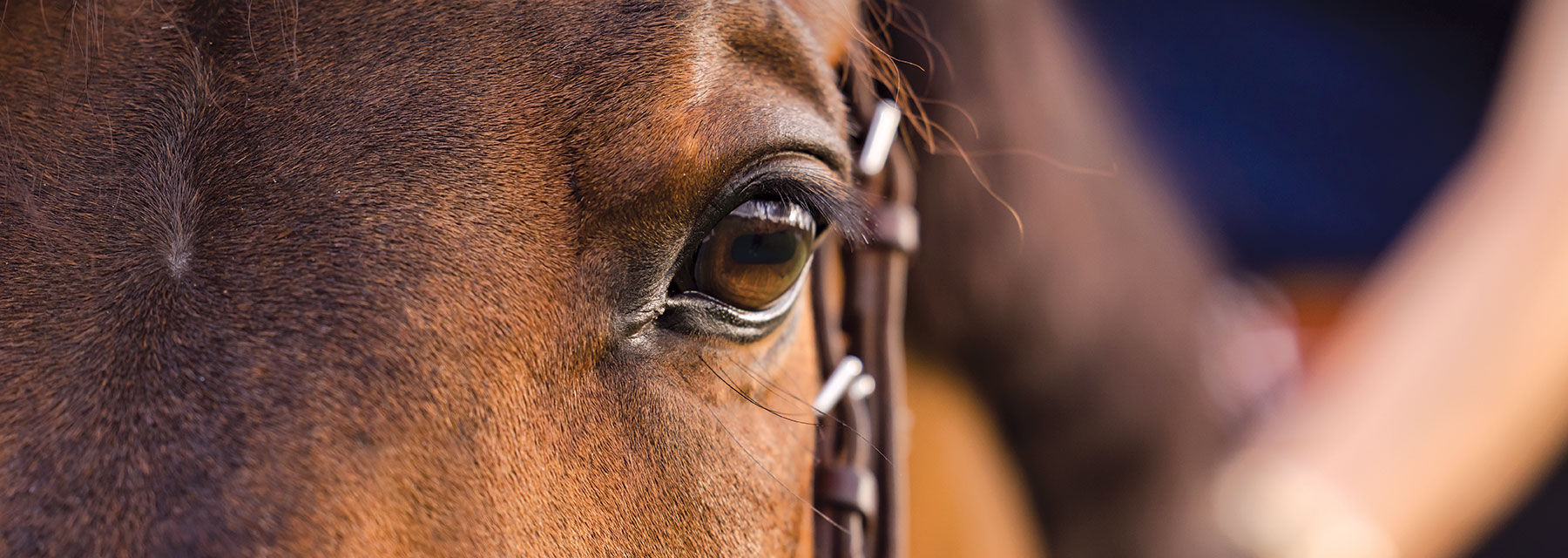Exploring the Multifaceted World of Sleep and Its Direct Impact on Your Horse’s Health and Performance
As humans, we profoundly understand the impact sleep has on our ability to function well and to our maximum potential. Quality sleep is often a deciding factor in a day’s productivity, our vibrance and, certainly, the ability to perform physically. Horses are no different; and while people and equines share innumerable similarities in body systems and functions, sleep poses a unique challenge to the mount as a modern, domesticated athlete. Their ability to sleep standing up is well known, but achieving quality sleep and the essential restorative benefits of rapid eye movement sleep, or REM, only occurs while they are lying down.
Veterinarian Christine Fuchs, (DVM, Ph.D., IAVC, IVCA), who specializes in orthopedics, chiropractic care, acupuncture, sleep laboratory and animal behavior and welfare at Lüsche Animal Clinic in Bakum, Germany, understands that sleep is a vast topic.
In addition to her research and daily clinical work, Dr. Fuchs is a Federation Equestre Internationale (FEI)-permitted treating veterinarian with significant experience at the highest level of equestrian sport. Many of her waking hours revolve around gaining greater knowledge and insights into the sleep patterns of horses and the resulting effects when they become sleep deprived. “There have been decades of research, but still very little is known about the complex function of sleep,” she says of a largely underappreciated area of veterinary medicine and equine management. “We know that sleep is natural, periodic and easily reversible. It involves both the body and mind.” Whether humans or horses, each species is less responsive to outside stimuli during the temporary suspension of consciousness known as sleep. Physically, muscles relax during this period. “Sleep is essential to life in all species and also vital to performance and well-being in the horse and human,” explains Dr. Fuchs. “It serves to regenerate us physically and psychologically. While the horse is sleeping, the brain is processing events and information from the preceding hours and days.”
Sleep Stages
| Rapid Eye Movement (REM) Sleep: Paradoxical Sleep | Non-REM Sleep: Light Sleep or Slow Wave Sleep |
|---|---|
| Rapid horizontal eye movement | Typically made up of several short periods of sleep |
| Low muscle tone; must lay down to achieve REM sleep | Can be achieved while standing or lying down |
| Dream sleep | Dreamless |
Measuring Sleep Stages
Using a diagnostic tool known as polysomnography (better known as sleep study or “sleep laboratory”), Dr. Fuchs can precisely measure several physiological functions during sleep, pinpointing the three stages (contrary to four sleep stages in humans) — the two non-rapid eye movement stages, or NREM sleep, and REM. “We simultaneously measure body functions, with the three most vital being: brain activity (measured with an electroencephalogram; eye movements (measured with an electrooculogram); and muscle tone (measured with an electromyogram),” she says. With these three diagnostic modalities, Dr. Fuchs and other researchers determine depth and quality of sleep.
To aid the research, great advancements in diagnostic resources continue to develop. Technology has improved, becoming faster, increasingly portable and user friendly. “We now have mobile sleep laboratories that are the size of a large smart phone,” Dr. Fuchs says. The device attaches to the horse’s neck, the electrodes connected to designated places on the animal’s head. Those positions are clipped before electrodes are temporarily glued in place and tethered to the device. The data is transmitted to a camera and onto a computer where Dr. Fuchs says: “We can see what’s happening in the brain, with the eyes and with the muscles all concurrently while watching video of the horse. The technology has greatly improved our capabilities.”
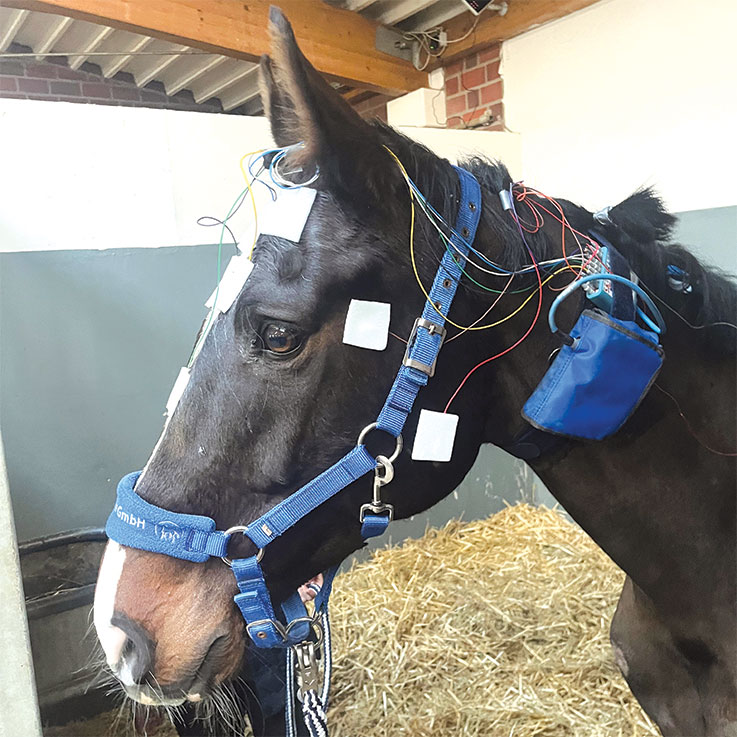
LEFT: Using a diagnostic tool known as polysomnography (better known as sleep study or “sleep laboratory”), Dr. Christine Fuchs can precisely measure several physiological functions during sleep, pinpointing the three stages — the two non-rapid eye movement stages and REM. “We simultaneously measure body functions, with the three most vital being: brain activity, eye movements and muscle tone,” she says. With these three diagnostic modalities, Dr. Fuchs and other researchers determine depth and quality of sleep.
COURTESY PHOTO
“There have been decades of research, but still very little is known about the complex function of sleep.”
— Dr. Christine Fuchs, Lüsche Animal Clinic in Bakum, Germany
“Horses can’t vocalize that something’s wrong, especially in the beginning. We have to be aware of the signs of sleep deprivation and what to look out for.”
— Dr. Christine Fuchs
Signs can include behavioral changes — lackadaisical, anxious or aggressive behavior — and diminished performance, as well as lacerations or repeated injuries typically suffered in the lower extremities: the dorsal fetlocks, carpal joints and, sometimes, at the hocks.
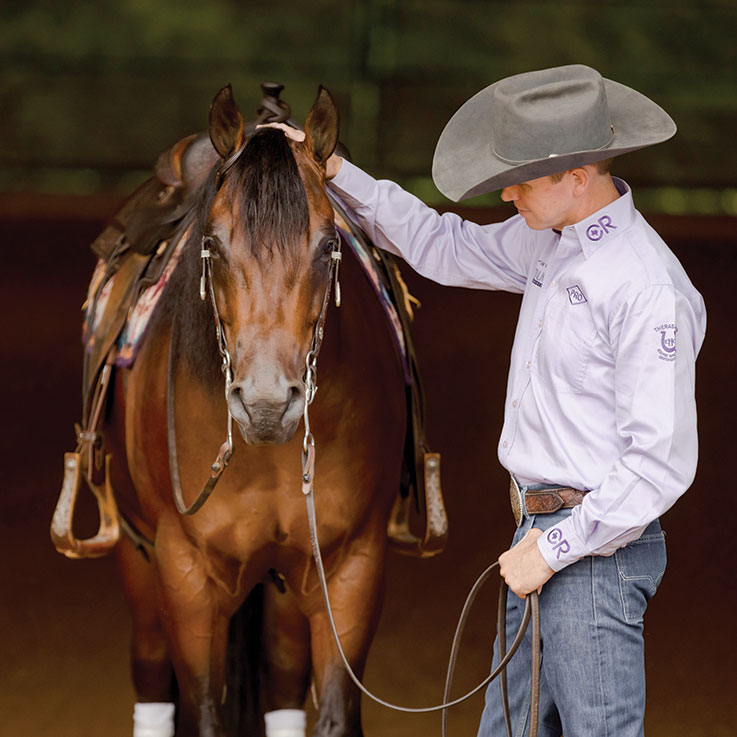
Working to ensure adequate sleep — REM sleep in particular — can impact not just performance but the horse’s overall health and longevity.
Sleep-deprived horses that start a REM sleep cycle while standing, naturally experience a loss of muscle tone leading to collapse.
Sleep Deprivation
People are familiar with the concept of “REM sleep,” the stage where most dreams occur, but what is it really, and what are the consequences for horses when they can’t achieve quality REM sleep? While the preceding NREM stages are restorative to some degree, REM sleep is essential for memory and cognitive health. But because it also results in loss of muscle tone, horses need to lie down to achieve it.
Problems associated with REM sleep deprivation usually develop slowly. Dr. Fuchs explains: “We know as humans, when we don’t sleep well, we can still function for quite a while before someone recognizes that we’re not well or not performing well. With horses, it can be similar.” Despite their size, horses evolved as prey animals, used to living and sleeping in a herd environment; it’s engrained in their DNA and a significant part of their evolutionary story. This complicates sleeping for wild horses and also affects the lives of domesticated performance horses. “Horses can’t vocalize that something’s wrong, especially in the beginning,” says Dr. Fuchs. “We have to be aware of the signs of sleep deprivation and what to look out for.” Those can include behavioral changes — lackadaisical, anxious or aggressive behavior — and diminished performance, as well as lacerations or repeated injuries typically suffered in the lower extremities: the dorsal fetlocks, carpal joints and, sometimes, at the hocks.
It seems difficult to believe that a horse can literally collapse from exhaustion, but thanks to the research of Dr. Fuchs and others, it’s a fact. Sleep-deprived horses that start a REM sleep cycle while standing, naturally experience a loss of muscle tone leading to collapse. And sleep deprivation is more common than once thought. “These repeated injuries are one of the most obvious signs of REM sleep deprivation, and they can indicate that the horse is experiencing collapses in the stall,” Dr. Fuchs points out. “In a study, we found that 90% of sleep-deprived horses will experience an injury like this. In some cases, we’ve even seen a fracture in the head or a tail fracture. It’s usually an injury that appears after the night, and there are no other explanations of where it may have come from. This should set a bell ringing in riders and veterinarians that we need to be looking at this horse’s sleep and its sleep environment.”
Light sleep and slow wave sleep during the NREM phase can occur while a horse is standing (with both able to be observed in a recumbent position as well), she says. It’s a common misconception that a horse can achieve REM sleep while standing. “Normally, horses lay down two to four times per night for a total of one to one-and-a-half hours,” Fuchs adds. “That’s normal sleep behavior for stalled horses.” A horse can endure three to four nights where they are unable to lay down. In nature, there would be instances of predators being present that would preclude a horse from achieving consistent quality REM sleep. It’s when a horse goes seven to 14 nights without proper REM sleep that problems begin, including collapses. “These can range from a slight stumbling to a complete and sudden collapse where the horse is rather violently falling down,” she says.
To better understand the impact of equine sleep deprivation, Dr. Fuchs has closely researched the natural herd environment that horses evolved within and how modern management may impede proper sleep. “Just the fact that we put horses in small box stalls is not normal for them,” she says. “They are herd animals and prey animals, and they’re accustomed to sleeping in large groups where some horses are standing and alert while others are sleeping and then vice versa.” In addition, researchers have reviewed bedding preferences and found horses prefer laying on straw to shavings for better quality sleep. “If we think about the travel and show environment, we see horses placed in small box stalls, often with shavings and away from their usual friends or their ‘herd,’ ” Dr. Fuchs says. “This can pose a real problem in terms of their sleep quality, especially when they’re expected to perform in competition.” Aside from unfamiliar surroundings, the environment inside the barn at shows can be problematic. “If you’ve ever been in one of these tents during the night, you’ll know that there’s usually light on and activity can start as early as three in the morning after the last competition may have ended at midnight.” Interrupted sleep and a hectic nighttime show environment can lead to a greater probability for downstream effects: stress-induced gastric ulcers, a compromised immune system, and diminished trainability and performance, she adds.
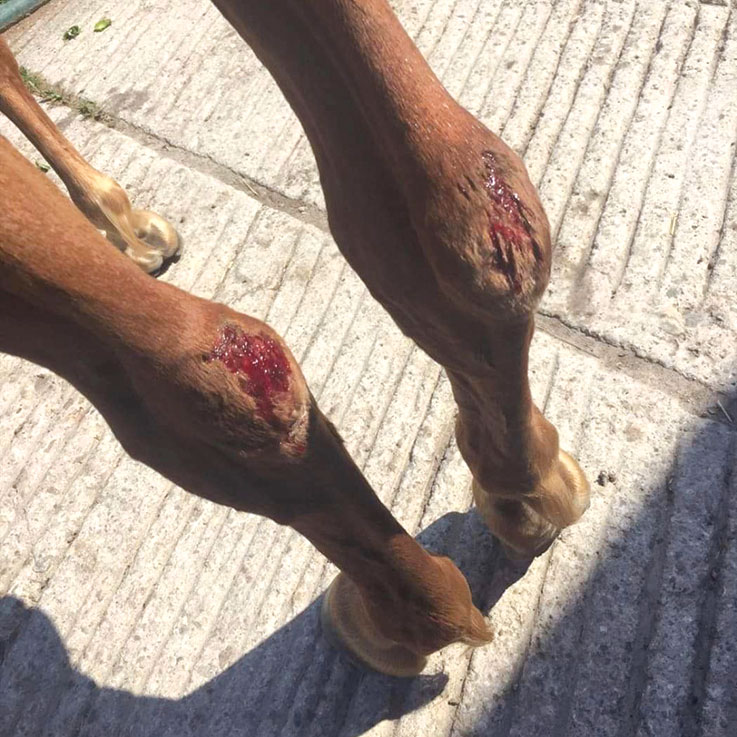
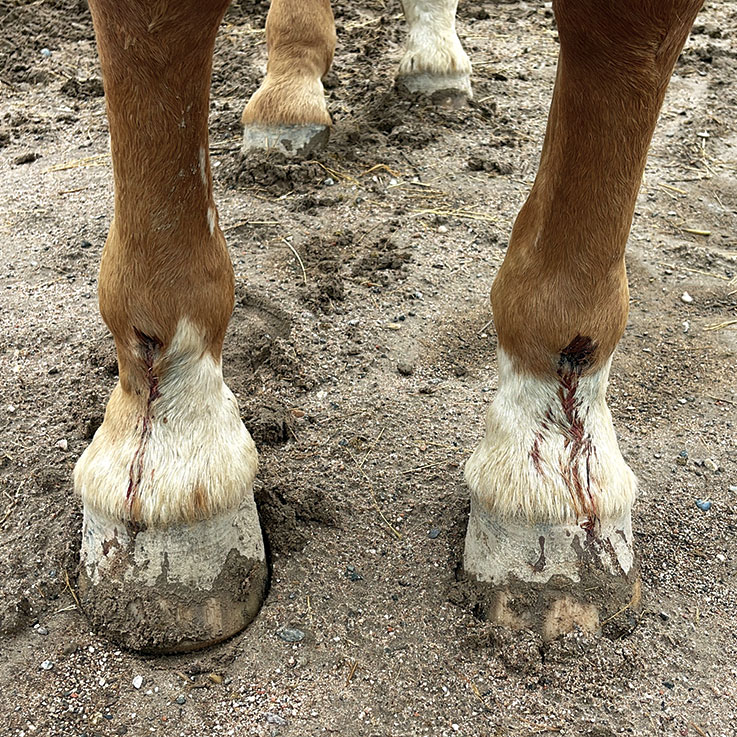
A horse can endure three to four nights where they are unable to lay down. It’s when a horse goes seven to 14 nights without proper rapid eye movement sleep that problems begin, including collapses.
Sleep Deprivation Causes
Sleep deprivation in horses can be caused by one or a combination of factors, with two of the most common categories being:
Pain or Discomfort:
Horses with severe arthritis or other lameness conditions, late-term pregnant mares or with other conditions that either make it difficult to get up and down or horses that are uncomfortable when recumbent do not obtain adequate REM sleep.
Environmental:
Horses with inadequate space or bedding, prolonged or excessive stress or anxiousness, separation from herd mates or other causes may have psychological or physical reasons to avoid lying down.
Narcolepsy
Most riders will admit that they’ve never thought narcolepsy existed in the horse. It’s a real thing — a neurological disorder resulting in excessive sleepiness during the day. But it’s also very rare. In her work, Dr. Fuchs has also closely studied narcolepsy to better understand this infrequent but debilitating disorder. “Usually, when a horse comes to me with suspected narcolepsy, it turns out to be REM sleep deprivation,” she assures. “Again, REM sleep deprivation is a behavioral issue where narcolepsy is a brain disorder.” While narcolepsy is more well-known in humans and dogs, Dr. Fuchs and other researchers know that the horse can follow suit by way of hypocretin, a vital neuropeptide regulating wakefulness and appetite, among other things. “Hypocretin is important for the sleep-wake cycle, and when we talk about narcolepsy, it’s usually the sleep-wake cycle we’re concerned about,” she explains. In dogs the disorder can occur due to heredity but also spontaneously and without any known genetic nexus. While dogs suffering from this form of narcolepsy have an adequate hypocretin level, they lack the receptors necessary for the hormone to perform its job properly. In contrast, dogs that suffer a spontaneous onset have an inadequate hypocretin level. “In horses we suspect that we only have the hereditary form of narcolepsy in young foals. The hypocretin levels in these horses so far have never been found to be low, so we expect a receptor problem, but it is not proven yet in horses,” clarifies Dr. Fuchs.
There is considerably more data — even video footage — of narcoleptic dogs than currently exists for horses. A quick internet search reveals the effect of the disorder, with dogs running around vigorously and normally, then suddenly dropping motionless in a narcoleptic episode known as cataplexy, or a sudden loss of muscle tone while awake. “They can’t move, but they’re totally aware of what’s happening around them,” Dr. Fuchs explains. Cataplexy in dogs and humans is known to occur after strong emotions, such as laughter or surprise, or in dogs, during feeding or play time. “Other signs are excessive sleepiness during the day, and in humans, hallucinations and sleep paralysis. We can’t be sure of the hallucinations and sleep paralysis in animals as of now because they simply can’t tell us,” she says.
Research pertaining to narcolepsy most often involves foals as their cataplexy usually begins when they’re one week to a few months old. “These collapses look quite similar to the ones in REM sleep deficiency,” Dr. Fuchs says of the findings. “But, they happen when the foal is awake, and there’s activity happening.” There are few definitive diagnostic tests and pharmaceutical treatments, however, and it’s suspected that foals may grow out of their cataplectic episodes or at least improve over time. With the condition being so rare, more research is needed.
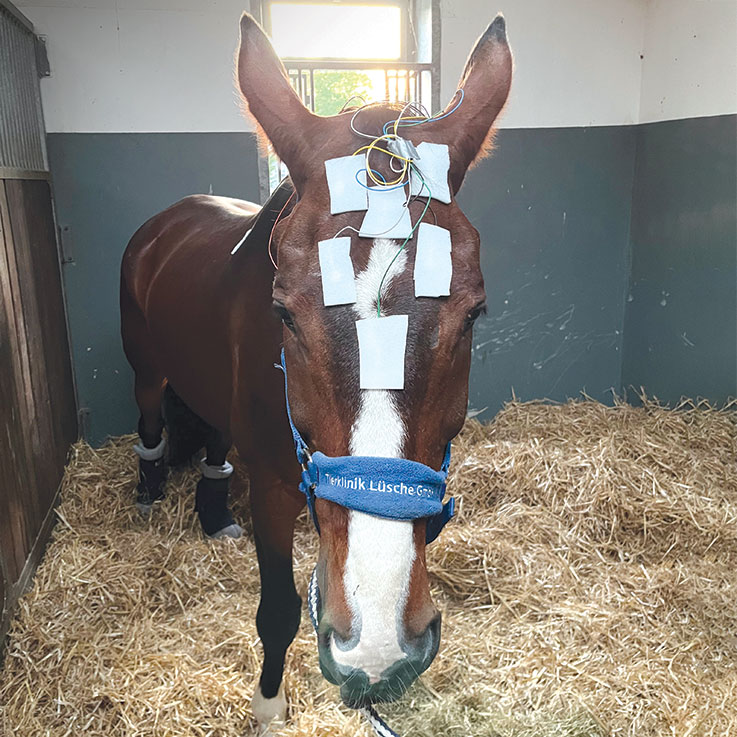
“Usually, when a horse comes to me with suspected narcolepsy, it turns out to be REM sleep deprivation,” Dr. Christine Fuchs assures. “Again, REM sleep deprivation is a behavioral issue where narcolepsy is a brain disorder.”
“Usually, when a horse comes to me with suspected narcolepsy, it turns out to be REM sleep deprivation,” Dr. Christine Fuchs assures. “Again, REM sleep deprivation is a behavioral issue where narcolepsy is a brain disorder.”
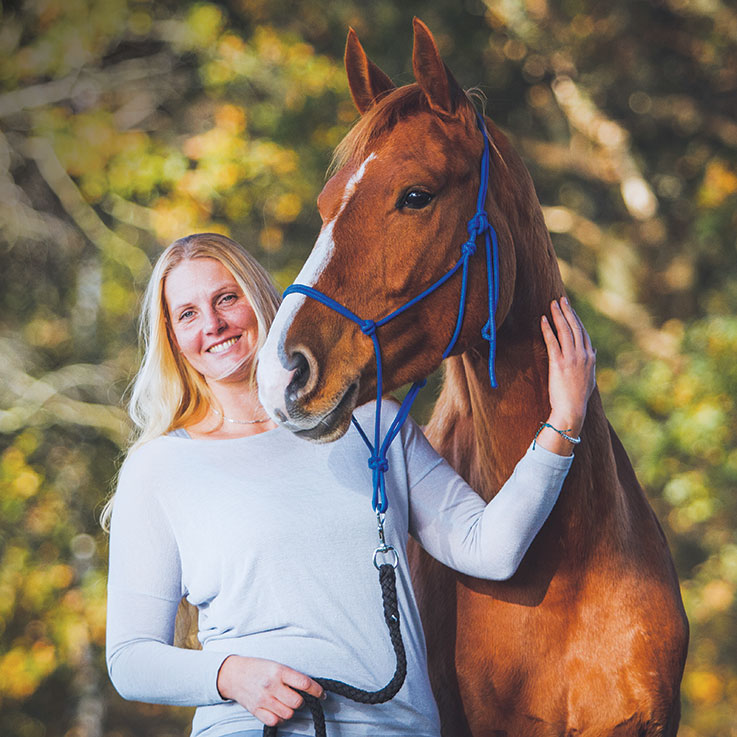
Dr. Christine Fuchs is dedicated to research that leads to a better understanding of the nuances of sleep and to helping advise veterinarians, trainers and riders on its importance to the horse’s continued vitality.
Dr. Christine Fuchs is dedicated to research that leads to a better understanding of the nuances of sleep and to helping advise veterinarians, trainers and riders on its importance to the horse’s continued vitality.
A Dream
Many riders take the sleep habits of their horses for granted. Like us, equines are not at their best when they haven’t achieved quality sleep, but theirs may be due to box stalls, lack of herd environment or the nighttime tumult of a show scene or during the wind-down after. Working to ensure adequate sleep — REM sleep in particular — can impact not just performance but the horse’s overall health and longevity. Dr. Fuchs is dedicated to research that leads to a better understanding of the nuances of sleep and to helping advise veterinarians, trainers and riders on its importance to the horse’s continued vitality. “Listen to the horse,” she urges. “They can tell us a lot if we pay attention. While we may think we’re doing the right thing with their stabling, for instance, their behavior will tell us if we’re correct or if we’ve misjudged their preferences.”
While considering innumerable factors in the pursuit of gaining a competitive edge, could sleep be the missing piece of the puzzle?
